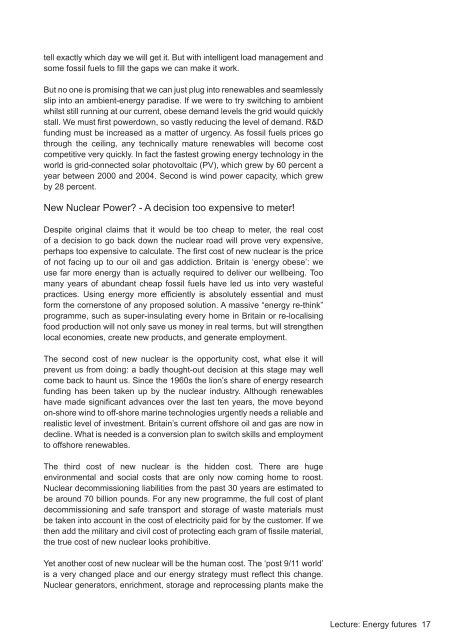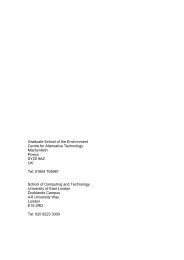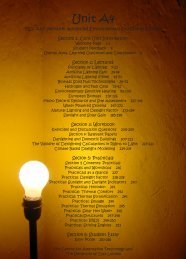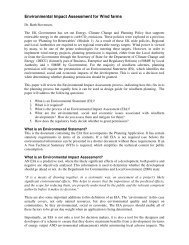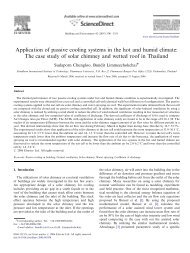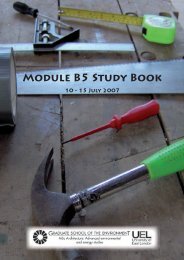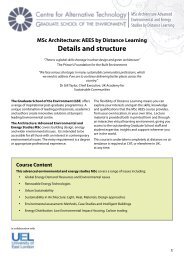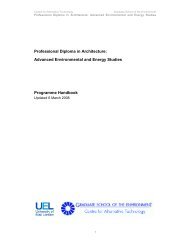Module B1 Study Book - the Graduate School of the Environment
Module B1 Study Book - the Graduate School of the Environment
Module B1 Study Book - the Graduate School of the Environment
Create successful ePaper yourself
Turn your PDF publications into a flip-book with our unique Google optimized e-Paper software.
tell exactly which day we will get it. But with intelligent load management and<br />
some fossil fuels to fill <strong>the</strong> gaps we can make it work.<br />
But no one is promising that we can just plug into renewables and seamlessly<br />
slip into an ambient-energy paradise. If we were to try switching to ambient<br />
whilst still running at our current, obese demand levels <strong>the</strong> grid would quickly<br />
stall. We must first powerdown, so vastly reducing <strong>the</strong> level <strong>of</strong> demand. R&D<br />
funding must be increased as a matter <strong>of</strong> urgency. As fossil fuels prices go<br />
through <strong>the</strong> ceiling, any technically mature renewables will become cost<br />
competitive very quickly. In fact <strong>the</strong> fastest growing energy technology in <strong>the</strong><br />
world is grid-connected solar photovoltaic (PV), which grew by 60 percent a<br />
year between 2000 and 2004. Second is wind power capacity, which grew<br />
by 28 percent.<br />
New Nuclear Power? - A decision too expensive to meter!<br />
Despite original claims that it would be too cheap to meter, <strong>the</strong> real cost<br />
<strong>of</strong> a decision to go back down <strong>the</strong> nuclear road will prove very expensive,<br />
perhaps too expensive to calculate. The first cost <strong>of</strong> new nuclear is <strong>the</strong> price<br />
<strong>of</strong> not facing up to our oil and gas addiction. Britain is ‘energy obese’: we<br />
use far more energy than is actually required to deliver our wellbeing. Too<br />
many years <strong>of</strong> abundant cheap fossil fuels have led us into very wasteful<br />
practices. Using energy more efficiently is absolutely essential and must<br />
form <strong>the</strong> cornerstone <strong>of</strong> any proposed solution. A massive “energy re-think”<br />
programme, such as super-insulating every home in Britain or re-localising<br />
food production will not only save us money in real terms, but will streng<strong>the</strong>n<br />
local economies, create new products, and generate employment.<br />
The second cost <strong>of</strong> new nuclear is <strong>the</strong> opportunity cost, what else it will<br />
prevent us from doing: a badly thought-out decision at this stage may well<br />
come back to haunt us. Since <strong>the</strong> 1960s <strong>the</strong> lion’s share <strong>of</strong> energy research<br />
funding has been taken up by <strong>the</strong> nuclear industry. Although renewables<br />
have made significant advances over <strong>the</strong> last ten years, <strong>the</strong> move beyond<br />
on-shore wind to <strong>of</strong>f-shore marine technologies urgently needs a reliable and<br />
realistic level <strong>of</strong> investment. Britain’s current <strong>of</strong>fshore oil and gas are now in<br />
decline. What is needed is a conversion plan to switch skills and employment<br />
to <strong>of</strong>fshore renewables.<br />
The third cost <strong>of</strong> new nuclear is <strong>the</strong> hidden cost. There are huge<br />
environmental and social costs that are only now coming home to roost.<br />
Nuclear decommissioning liabilities from <strong>the</strong> past 30 years are estimated to<br />
be around 70 billion pounds. For any new programme, <strong>the</strong> full cost <strong>of</strong> plant<br />
decommissioning and safe transport and storage <strong>of</strong> waste materials must<br />
be taken into account in <strong>the</strong> cost <strong>of</strong> electricity paid for by <strong>the</strong> customer. If we<br />
<strong>the</strong>n add <strong>the</strong> military and civil cost <strong>of</strong> protecting each gram <strong>of</strong> fissile material,<br />
<strong>the</strong> true cost <strong>of</strong> new nuclear looks prohibitive.<br />
Yet ano<strong>the</strong>r cost <strong>of</strong> new nuclear will be <strong>the</strong> human cost. The ‘post 9/11 world’<br />
is a very changed place and our energy strategy must reflect this change.<br />
Nuclear generators, enrichment, storage and reprocessing plants make <strong>the</strong><br />
Lecture: Energy futures 17


